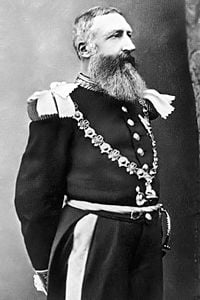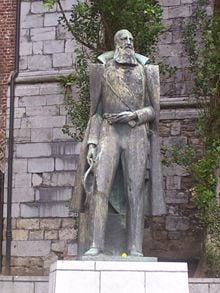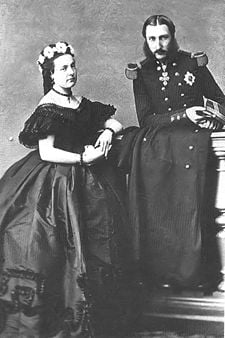Encyclopedia, Difference between revisions of "Leopold II of Belgium" - New World
(copy/credit Wiki) |
(cat, claim, epname) |
||
| Line 1: | Line 1: | ||
| + | {{Claimed}} | ||
| + | {{epname}} | ||
| + | |||
{{Infobox_Monarch | name =Leopold II | {{Infobox_Monarch | name =Leopold II | ||
| title =King of the Belgians | | title =King of the Belgians | ||
| Line 166: | Line 169: | ||
| − | + | [[Category:History and biography]] | |
{{Credit|97432109}} | {{Credit|97432109}} | ||
Revision as of 19:14, 31 December 2006
| Leopold II | ||
|---|---|---|
| King of the Belgians | ||

| ||
| Reign | 10 December 1865-17 December, 1909 | |
| Born | 9 April 1835 | |
| Brussels, Belgium | ||
| Died | 17 December 1909 | |
| Laeken, Belgium | ||
| Predecessor | Leopold I | |
| Successor | Albert I | |
| Consort | Marie Henriette of Austria Caroline Lacroix {morgantic realtionship} | |
| Issue | Princess Louise-Marie Prince Leopold Princess Stephanie Princess Clementine | |
| Royal House | Wettin (Saxe-Coburg-Gotha line) | |
| Father | Leopold I | |
| Mother | Louise-Marie of France | |
Leopold II of the Belgians (April 9 1835 – December 17 1909) succeeded his father, Leopold I of Belgium, to the Belgian throne in 1865 and remained king until his death. He was the brother of Charlotte, Empress of Mexico and cousin to Queen Victoria. Outside of Belgium, he is chiefly remembered as the founder and sole owner of the Congo Free State, a private project undertaken by the King to extract rubber and ivory, which relied on forced labour.
Biography
Leopold II married on August 22 1853, he was married to Marie Henriette Anne von Habsburg-Lothringen, Archduchess of Austria.
Leopold II and Marie Henriette Anne's children were:
- Louise-Marie Amélie, born Brussels February 18, 1858 and died at Wiesbaden March 1, 1924. She married Prince Philipp of Saxe-Coburg and Gotha.
- Léopold Ferdinand Elie Victor Albert Marie, Count of Hainaut (as eldest son of the heir apparent), Duke of Brabant (as heir apparent), born at Laeken on June 12 1859 and died at Laeken on January 22 1869 from pneumonia, after falling into a pond.
- Stéphanie Clotilde Louise Herminie Marie Charlotte, born at Laeken on May 21 1864, and died at the Archabbey of Pannonhalma in Győr-Moson-Sopron, Hungary on August 23 1945. She married (1) Crown Prince Rudolf of Austria and then (2) Elemér Edmund Graf Lónyay de Nagy-Lónya et Vásáros-Namény (created, in 1917, Prince Lónyay de Nagy-Lónya et Vásáros-Namény).
- Clémentine Albertine Marie Léopoldine, born at Laeken on July 30 1872 and died at Nice on March 8 1955. She married Prince Napoléon Victor Jérôme Frédéric Bonaparte (1862 - 1926), head of the Bonaparte family.
Leopold II was also the father of two sons, Lucien Philippe Marie Antoine (1906-1984) and Philippe Henri Marie François (1907-1914), born out of wedlock. Their mother was Blanche Zélia Joséphine Delacroix (1883-1948), aka Caroline Lacroix, a prostitute who married the king on December 12 1909, in a religious ceremony with no validity under Belgian law, at the Pavilion of Palms, Château de Laeken, five days before his death [citation needed]. These sons were adopted in 1910 by Lacroix's second husband, Antoine Durrieux. Though Lacroix is said to have been created Baroness de Vaughan, Lucien the Duke of Tervuren, and Philippe the Count of Ravenstein, no such royal decrees were ever issued [citation needed].
On November 15 1902, Italian anarchist Gennaro Rubino unsuccessfully attempted to assassinate King Leopold. Leopold was riding in a royal cortege from a ceremony in memory of his recently-deceased wife, Marie Henriette. After Leopold's carriage passed, Rubino fired three shots at the King. Rubino's shots missed Leopold entirely and Rubino was immediately arrested at the scene.
In Belgian domestic politics, Leopold emphasized military defense as the basis of neutrality, but he was unable to obtain a universal conscription law until on his death bed. He died on December 17 1909, and was interred in the Royal vault at the Church of Our Lady, Laeken Cemetery, Brussels, Belgium.
Private colonialism
Leopold fervently believed that overseas colonies were the key to a country's greatness, and he worked tirelessly to acquire colonial territory for Belgium. Neither the Belgian people nor the Belgian government were interested, however, and Leopold eventually began trying to acquire a colony in his private capacity as an ordinary citizen.
After a number of unsuccessful schemes for colonies in Africa or Asia, in 1876 he organized a private holding company disguised as an international scientific and philanthropic association, which he called the International African Society.
In 1876, under the auspices of the holding company, he hired the famous explorer Henry Morton Stanley to establish a colony in the Congo region. Much diplomatic maneuvering resulted in the Berlin Conference of 1884–85, at which representatives of thirteen European countries and the United States recognized Leopold as sovereign of most of the area he and Stanley had laid claim to. On February 5 1885, the result was the Congo Free State (later the Belgian Congo, then the Democratic Republic of Congo, then Zaire, and now the Democratic Republic of Congo again), an area 76 times larger than Belgium, which Leopold was free to rule as a personal domain through his private army, the Force Publique.
Reports of outrageous exploitation and widespread human rights abuses (including enslavement and mutilation of the native population), especially in the rubber industry, led to an international protest movement in the early 1900s. Forced labor was extorted from the natives. Estimates of the death toll range from 2 to 15 million (for further detail, see Congo Free State ([1]) and many historians consider the atrocities to have constituted a genocide.
Finally, in 1908, the Belgian parliament compelled the King to cede the Congo Free State to Belgium. Historians of the period tend to take a very dim view of Leopold, due to the mass killings and human rights abuses that took place in the Congo: one British historian has said that he "was an Attila in modern dress, and it would have been better for the world if he had never been born". Emperor Franz Joseph of Austria-Hungary once described his fellow ruler as a "thoroughly bad man".
Missionary John Harris of Baringa, for example, was so shocked by what he had come across that he felt moved to write a letter to Leopold's chief agent in the Congo:
"I have just returned from a journey inland to the village of Insongo Mboyo. The abject misery and utter abandon is positively indescribable. I was so moved, Your Excellency, by the people's stories that I took the liberty of promising them that in future you will only kill them for crimes they commit."
Leopold II is still a controversial figure in the Democratic Republic of Congo; in 2005 his statue was taken down just hours after it was re-erected in the capital, Kinshasa. The Congolese culture minister, Christoph Muzungu, decided to reinstate the statue, arguing people should see the positive aspects of the king as well as the negative. But just hours after the six-metre (20 foot) statue was erected in the middle of a roundabout near Kinshasa's central station, it was taken down again, without explanation.
The campaign to report on Leopold's "secret society of murderers," led by diplomat Roger Casement, and a former shipping clerk E. D. Morel, became the first mass human rights movement ([2]).
Leopold and the Belgians
Though extremely disliked by Belgians at end of his reign - he was booed during his burial parade - Leopold II is perceived today by many Belgians as the "King-Builder" ("le Roi-Bâtisseur" in French, "Koning-Bouwer" in Dutch) because he commissioned a great number of buildings and urban projects in Belgium (mainly in Brussels, Ostend and Antwerp).
These buildings include the Royal Glasshouses at Laeken (in the domain of the Royal Palace of Laeken), the Japanese tower, the Chinese Pavilion, the Musée du Congo (now called the Royal Museum for Central Africa) and their surrounding park in Tervuren, the Cinquantenaire in Brussels and the Antwerp train station hall. He also built an important country estate in Saint-Jean-Cap-Ferrat on the French Riviera in France, including the Villa des Cèdres, which is now a botanical garden. These were all built using the profits from the Congo.
There has been a "Great Forgetting", as Adam Hochschild puts it in King Leopold's Ghost, after Leopold's Congo was transferred to Belgium. In Hochschild's words:
Remarkably, the colonial Royal Museum for Central Africa (Tervuren Museum) did not mention anything at all regarding the atrocities committed in the Congo Free State. The Tervuren Museum has a large collection of colonial objects but of the largest injustice in Congo, "there is no sign whatsoever" (in Hochschild's words again). Another example is to be found on the sea walk of Blankenberge, a popular coastal resort, where a monument shows a colonialist with a black child at his feet (supposedly bringing "civilisation") without any comment, further illustrating this "Great Forgetting".
Writings about Leopold
| Template:Infobox hrhstyles |
Many prominent writers of the time took part in international condemnation of Leopold II's exploitation of the Congo, including Arthur Conan Doyle, Booker T. Washington, and those mentioned below.
- The American mystic poet Vachel Lindsay wrote: "Listen to the yell of Leopold's ghost / Burning in Hell for his hand-maimed host / Hear how the demons chuckle and yell / Cutting his hands off, down in Hell."
- King Leopold's Ghost by Adam Hochschild describes the history and brutality of King Leopold's rule in the Belgian Congo.
- King Leopold's Belgian Congo was described as a colonial regime of slave labor, rape and mutilation in Joseph Conrad's Heart of Darkness.
- Mark Twain wrote a biting sarcastic political satire, King Leopold's Soliloquy.
- In his novel Tarzan of the Apes, Edgar Rice Burroughs mentions King Leopold and the Congo Free State, referring to Leopold as "that arch hypocrite" whose "atrocities" outmatched the cruelty of the worst cannibal tribes of Africa [3].
More references
- Neal Ascherson: The King Incorporated, Allen & Unwin, 1963. ISBN 1-86207-290-6 (1999 Granta edition).
- Mass crimes against humanity in the Congo Free State
- Adam Hochschild: King Leopold’s Ghost: A Story of Greed, Terror, and Heroism in Colonial Africa, Mariner Books, 1998. ISBN 0-330-49233-0.
- Maria Petringa: Brazza, A Life for Africa, AuthorHouse, 2006. ISBN 978-1-4259-1198-0
Miscellaneous
Congo: White king, red rubber, black death (2003) is a documentary by Peter Bate (BBC) on Leopold II and the Congo (see also: BBC page).
External links
- "The Political Economy of Power" Podcast interview with political scientist Bruce Bueno de Mesquita, with an extended discussion of Leopold II starting at the halfway mark
- "Reforming The Heart of Darkness" The Congo under Leopold II
- Interview with King Leopold II Publishers' Press, 1906
| House of Saxe-Coburg and Gotha Born: 9 April 1835; Died: 17 December 1909 | ||
|---|---|---|
|
| ||
| Preceded by: Leopold I |
King of the Belgians 1865-1909 |
Succeeded by: Albert I |
| Vacant Title last held by Philip II |
Duke of Brabant 1840-1865 |
Succeeded by: Prince Leopold, Duke of Brabant |
| Persondata | |
|---|---|
| NAME | Leopold II |
| ALTERNATIVE NAMES | |
| SHORT DESCRIPTION | King of the Belgians |
| DATE OF BIRTH | April 9 1835 |
| PLACE OF BIRTH | Brussels, Belgium |
| DATE OF DEATH | December 17 1909 |
| PLACE OF DEATH | |
bg:Леополд II (Белгия) ca:Leopold II de Bèlgica da:Leopold 2. af Belgien de:Leopold II. (Belgien) es:Leopoldo II de Bélgica eo:Leopoldo la 2-a (Belgio) fr:Léopold II de Belgique it:Leopoldo II del Belgio he:לאופולד השני מלך הבלגים ln:Léopold II nl:Leopold II van België ja:レオポルド2世 (ベルギー王) no:Leopold II av Belgia nn:Leopold II av Belgia pl:Leopold II Koburg pt:Leopoldo II da Bélgica ru:Леопольд II (король Бельгии) fi:Leopold II (Belgia) sv:Leopold II av Belgien tr:II. Léopold (Belçika Kralı) wa:Yopôl II d' Beldjike zh:利奥波德二世 (比利时)
Credits
New World Encyclopedia writers and editors rewrote and completed the Wikipedia article in accordance with New World Encyclopedia standards. This article abides by terms of the Creative Commons CC-by-sa 3.0 License (CC-by-sa), which may be used and disseminated with proper attribution. Credit is due under the terms of this license that can reference both the New World Encyclopedia contributors and the selfless volunteer contributors of the Wikimedia Foundation. To cite this article click here for a list of acceptable citing formats.The history of earlier contributions by wikipedians is accessible to researchers here:
The history of this article since it was imported to New World Encyclopedia:
Note: Some restrictions may apply to use of individual images which are separately licensed.


